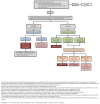Respiratory Distress in the Newborn with Primary Ciliary Dyskinesia
- PMID: 33670529
- PMCID: PMC7922088
- DOI: 10.3390/children8020153
Respiratory Distress in the Newborn with Primary Ciliary Dyskinesia
Abstract
Primary ciliary dyskinesia (PCD) is inherited in a predominantly autosomal recessive manner with over 45 currently identified causative genes. It is a clinically heterogeneous disorder that results in a chronic wet cough and drainage from the paranasal sinuses, chronic otitis media with hearing impairment as well as male infertility. Approximately 50% of patients have situs inversus totalis. Prior to the development of chronic oto-sino-pulmonary symptoms, neonatal respiratory distress occurs in more than 80% of patients as a result of impaired mucociliary clearance and mucus impaction causing atelectasis and lobar collapse. Diagnosis is often delayed due to overlapping symptoms with other causes of neonatal respiratory distress. A work up for PCD should be initiated in the newborn with compatible clinical features, especially those with respiratory distress, consistent radiographic findings or persistent oxygen requirement and/or organ laterality defects.
Keywords: neonatal respiratory distress; primary ciliary dyskinesia.
Conflict of interest statement
The authors declare no conflict of interest.
Figures



References
-
- Zariwala M.A., Knowles M.R., Leigh M.W. In: Primary Ciliary Dyskinesia, in GeneReviews((R)) Adam M.P., editor. Europe PMC; London, UK: 1993.
Publication types
LinkOut - more resources
Full Text Sources
Other Literature Sources

